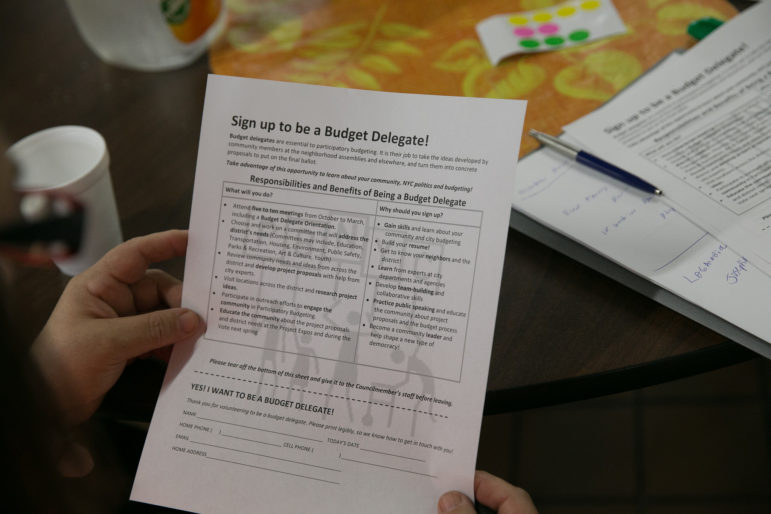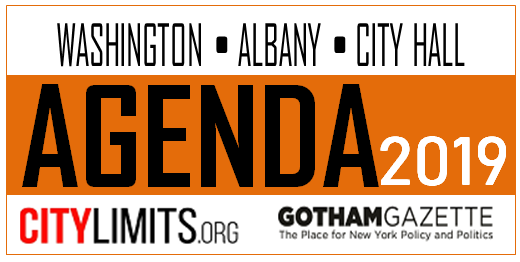
William Alatriste for the New York City Council
A scene from participatory budgeting in Council district 3 in 2014.
Mayor de Blasio’s early 2018 call to strengthen New York City’s democracy won public endorsement in November, when voters approved charter revisions reducing maximum campaign donations, curtailing community-board members’ terms and creating both a Civic Engagement Commission and a new, citywide participatory budgeting process.
The large margin of approval for de Blasio’s proposals—none received less than 65 percent of the vote—was a victory for the mayor. But when it comes to participatory budgeting, the work of actually making the city’s democracy more vibrant is just beginning.
Citywide participatory budgeting, or “PB,” will be a new take on the practice of letting residents of Council districts vote on how their Councilmember should spend a portion of her or his discretionary budget, which has been in place in some areas of the city since 2011.
The provision backed by voters last month was bare-boned, however, offering no details on how much money would be allocated by the citywide PB process, whether operating expenses will be part of it along with capital dollars, what the annual timeline will be and how the new system will interact with the existing Council PB process, which last year involved 31 of 51 members.
Another big question is how much staff and other resources the city will devote to operating the new system—an element that is vitally important, people familiar with the current process tell City Limits.
The first round of citywide participatory budgeting will play out in late 2019 and early 2020, in time to affect the fiscal 2021 budget that begins on July 1, 2020 and ends on June 30, 2021. That means citywide PB will impact the last two budgets of de Blasio’s mayoralty. It also means key decisions about how to structure the citywide PB process must be made during the first part of 2019.
Sharing power
PB has been practiced since 1989, getting its start in Latin America and Europe. Four New York City Councilmembers embraced it in 2011 and the number of participating members has grown steadily since.
Under PB, Councilmembers agree to appropriate at least $1 million of their annual discretionary funding to projects selected by the community. Each budget season, beginning in the autumn, staff and volunteers in participating districts identify community needs, research the viability of projects to address those needs and present a list of options for a public vote in the spring. Voting is open to all residents, regardless of citizenship or immigration status, who are older than 11. The top few vote-getting projects get funded.
Over seven budget cycles, more $200 million has been spent through PB on some 700 projects including computer carts for schools, tree guards, lighting for NYCHA developments and air-conditioning for libraries. But the dollar impact is greater than that, because some lawmakers use the ideas and preferences revealed through PB to guide their other budget decisions.
“One of the things that I like about participatory budgeting myself is the idea generation,” says Andrew Cohen, a Councilmember representing the northwest Bronx. “Sometimes somebody will come up with an idea that won’t fit for PB. But that doesn’t mean I can’t come up with a way that I can do something about it.” Early in his tenure, a idea for a “tot lot” – a playground designed specifically for very small children—came in through PB. “And it was a great idea. Even though it wasn’t appropriate for participatory budgeting. Someday it will get built. Probably this spring.”
Proponents of PB say the monetary impact is just one purpose of the project. It’s also intended to get people involved in collective discussions about policy, provide a forum for real-world civics education, and spur other kinds of engagement, like voting: One study found that people who participated in PB were 7 percent more likely to vote in the next election than those who didn’t participate in PB. “It’s been a pipeline for deeper participation,” says Josh Lerner, co-founder and co-executive director of the Participatory Budgeting Project.
Debi Rose, a Staten Island Councilmember, says people involved in PB in her district who used to not understand which part of government could address basic complaints now grasp how the budget and the Council work. “It’s been a wonderful entry-point to government,” she says. “And it’s been a great civics lesson.”
Not everything goes smoothly. Capital projects approved via PB take just as long as other capital work. Often, Cohen says, “People want to see the work come to fruition and it takes a disheartening amount of time to bring it to completion.” Some residents have complained about city agencies being unreceptive to new ideas, and others wonder if the effort is inclusive enough: While it’s impressive that more than 99,000 people took part in the PB process in 2018, that represents about one-twelfth the turnout in the city’s 2017 election.
Some skeptics see participatory budgeting as a time-consuming distraction, demanding a lot of commitment from participants in exchange for limited say over a very small piece of the city’s massive spending. Last year, the PB process allocated $37 million, which is a rounding error in the city’s $11 billion FY2019 capital budget. “The city budget is overwhelmingly in the mayor’ s hand, says longtime organizer Michael Gecan. “So doing PB about a minor percentage of the budget takes the focus off the key source and controlling driver of the budget—the mayor.”
Open questions, ticking clock
The citywide effort could counter some of those criticisms. But that will depend on how much money is put on the table and how seriously the city invests time and money in the process, sources told City Limits.
According to City Hall, decisions on staffing, the size of the budget and the type of money involved in citywide PB have yet to be made.
Based on what other cities like Paris and Madrid have done—and given New York’s larger population, “to be a real, world-class process, we recommend $500 million” as the amount of money the citywide PB process would allocate, says Lerner. (He notes that $200 million would give New York the biggest program in the world overall, though not per capita.)
As for where the money comes from, Lerner says it should be a mix of capital money—which builds stuff—and expense money that pays for programming and services. Only a few Councilmembers have offered up expense money for PB, “but the citywide process offers more opportunities to that,” Lerner says. “People have been more excited about the expense funds projects than the capital funds.”
It’s unclear what the timeline for the citywide effort will be and how it will interact with the existing, Council-level participatory budgeting process. As it is, the Council-level process can feel rushed, Lerner says. He’s hoping for a process that ties the citywide and district-level vetting and voting together and starts earlier in the fiscal year. He also hopes the city integrates the PB process with other parts of de Blasio’s democracy initiative, like the chief democracy officer.
Staffing, however, is the biggest wild card. “With more support for community outreach, for facilitating discussions, then could see more people participating in that stage of the process,” Lerner says. “If the goal is to engage people in the commenting, we hope that there’s really strong staffing to support that work.”
Staffing PB “is a definite challenge because it’s sort of uneven,” says Cohen. “Some years we have a strong stable of volunteers who can do a lot on their own and other years we have people who need a lot of hand-holding.” He usually devotes one staffer to the effort with some support from another.
Rose says she was a late convert to PB largely because of the demands she knew it would put on her staff. “There are always people who are overly involved” in civics, Rose says. “But I wanted the people who weren’t, because I found they were often frustrated with me because they didn’t understand how the process worked.” She says she did broad outreach to neighborhoods and community groups—an effort that she says paid off but took a great deal of investment. “That’s why I didn’t do it in the beginning, because it is very labor intensive and I had to feel like I was at a point where I could dedicate a staff member to oversee it – and even still, it wasn’t her only responsibility.”
“It is labor intensive,” she adds. “Oh my God, it really is!”
The first key personnel decisions will come when the Civic Engagement Commission—whose members start their terms in April—names the members of the Participatory Budgeting Commission.
Against worries that the CEC will be too dominated by the mayor, some hope the choice of who sits on those commissions will itself reflect a high degree of engagement.
“We’re not starting from scratch here. There is an army of organizations and volunteers, many of whom are battle-tested and incredibly knowledgeable, about how to make participatory budgeting work,” says Menchaca. “This is the people’s budget. They need to be at the table from day one. It can only work with and because of them.”









2 thoughts on “Key Decisions Loom for Citywide Effort to Involve Residents in Budget Decisions”
PB sounds good but it’s absurd to open it to non-citizens and children age 11. I’m confused about how this new version of PB will work. Is there going to be one large city-wide PB allocation that the entire city can vote on or will each of the 51 Council Districts receive an individual PB allocation that only those who live in the district can vote on? I prefer the latter scenario.
I was involved in the Participatory Budgeting process in Queens for two cycles.
My experience about the process is very positive. City residents were very interested in the process and the number of people who voted had increased with added publicity. And, using the adage that “involvement equals commitment” expanding this process has the potential for really positive results.
One suggestion would be to place some parameters on the percentage of dollars that supports any single agency. Otherwise, support for school items will suck up a disproportionate share of the funds. Schools are, obviously, very important and a primary concern for all residents. However, DOE has a budget of $25,600,000,000 and one would think that it should be able to fund its own participatory programs. I would recommend that at least 60% of the funds should be reserved for non-school related funding. This would ensure that parks, safety and other quality of life items receive a proportion of funding.